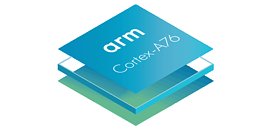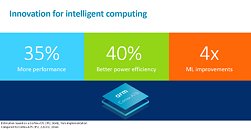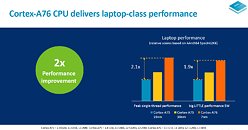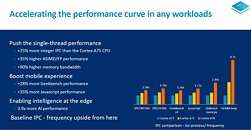Friday, June 1st 2018
An ARM to Rule Them All: ARM 76 To Challenge x86 Chips in the Laptop Space?
ARM has announced their next, high-performance computing solution with their A76 design, which brings another large performance increase to the fledgling architecture. having been touted for some time as a true contender to the aging x86 architecture, ARM has had a way of extracting impressive performance increases with each iteration of its computing designs, in the order of 20% do 40% performance increases in an almost annual basis. Compare that to the poster-child of x86 computing, Intel, and its passivity-fueled 5 to 10% yearly performance increases, and the projections aren't that hard to grasp: at some point in time, ARM cores will surpass x86 in performance - at least on the mobility space.
The new ARM A76 design, to be manufactured on the 7 nm process, brings about a 35% increase in performance compared to last years' A75. This comes with an added 40% power efficiency (partly from the 10 nm to 7 nm transition, the rest from architecture efficiency and performance improvements), despite the increase to maximum 3.0 GHz clocks. With the added performance, ARM is saying the new A76 will deliver 4x the Machine Learning performance of its previous A75 design.Adding to those CPU performance improvements, is ARM's Mali-G76 GPU solution, which also packs some 30% increases in performance density (meaning, for the same silicon footprint, added 30% performance), accompanied by 30% better energy efficiency and 2.7x increased Machine Learning performance for GPU-accelerated workloads. The new GPU architecture supports up to three execution engines per shader core, features a dual texture mapper, presents configurable 2-4 slices of L2 cache, and supports up to 20 "cores" in devices for process and workload distribution.This combination of CPU (with the ARM A76) and GPU (with the Mali-G76) performance improvements mean that ARM is now within spitting distance of x86 solutions in the mobile space; this, and the future performance projections should ARM be able to keep its development and performance improvement pace, may be one of the reasons why Microsoft invested the way it did in adding ARM support for its Windows operating system in recent times. ARM solutions that employ Microsoft's OS do provide better battery life than their x86 counterparts, and with the latest ARM 76 improvements, which are seemingly more significant than any x86 performance and efficiency increases in recent times, may well mean a push for x86 towards higher levels of required performance, leaving the entry productivity and content consumption scenarios for ARM-powered devices and architectures.
Sources:
AnandTech, Tom's Hardware
The new ARM A76 design, to be manufactured on the 7 nm process, brings about a 35% increase in performance compared to last years' A75. This comes with an added 40% power efficiency (partly from the 10 nm to 7 nm transition, the rest from architecture efficiency and performance improvements), despite the increase to maximum 3.0 GHz clocks. With the added performance, ARM is saying the new A76 will deliver 4x the Machine Learning performance of its previous A75 design.Adding to those CPU performance improvements, is ARM's Mali-G76 GPU solution, which also packs some 30% increases in performance density (meaning, for the same silicon footprint, added 30% performance), accompanied by 30% better energy efficiency and 2.7x increased Machine Learning performance for GPU-accelerated workloads. The new GPU architecture supports up to three execution engines per shader core, features a dual texture mapper, presents configurable 2-4 slices of L2 cache, and supports up to 20 "cores" in devices for process and workload distribution.This combination of CPU (with the ARM A76) and GPU (with the Mali-G76) performance improvements mean that ARM is now within spitting distance of x86 solutions in the mobile space; this, and the future performance projections should ARM be able to keep its development and performance improvement pace, may be one of the reasons why Microsoft invested the way it did in adding ARM support for its Windows operating system in recent times. ARM solutions that employ Microsoft's OS do provide better battery life than their x86 counterparts, and with the latest ARM 76 improvements, which are seemingly more significant than any x86 performance and efficiency increases in recent times, may well mean a push for x86 towards higher levels of required performance, leaving the entry productivity and content consumption scenarios for ARM-powered devices and architectures.








74 Comments on An ARM to Rule Them All: ARM 76 To Challenge x86 Chips in the Laptop Space?
The hARM has already been done.
Lets hope then ARM can capitalise on this emerging laptop craze.
The mobile market is plateauing , it's not reached it's cap yet. The whole of South Asia, most populous region in the world, as well as Africa is yet to be fully tapped. So while the per unit sales is probably going down down, the overall unit sales are yet to peak.
Binaries aren't compatible, of course.
If they can get more performance per ARM core. I personally think Windows on ARM is a great concept, provided the performance penalty isn't too high & we get a lot more regular applications to work on these devices.
Also the battery life, ARM chips are great for <10W TDP, in fact better than x86 chips.
Lastly price, I can't say how much a flagship ARM SoC costs, but with integrated BT, wifi & (4G) cellular connectivity it's cheaper than any other solution out there.
That last bit is very important, as many people still don't have access to wifi, free or otherwise, around the world. They'll probably be near 3G or 4G cell sites though.
Apple's doing something similar & they have enough $ to pull it off. MS just needs to back this long & hard.
But where I was going is, if ARM needs a solution to put their CPUs in desktops and/or laptops, they can use Linux today. Not saying they will, but they can. Interesting days ahead, regardless.